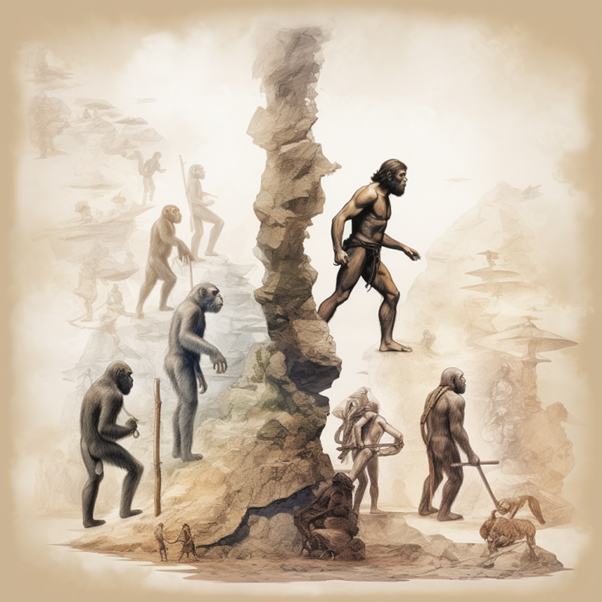The narrative of human evolution is a captivating saga that takes us back millions of years, tracing the roots of our existence. This article delves into the intricate tapestry of our shared DNA with other hominids, the unique traits that distinguish us, and the ongoing debate surrounding human evolution.
The Genetic Bond: Humans and Hominids
Our genetic blueprint uncovers a shared lineage with other hominids. Astonishingly, humans share 99% of their DNA with chimpanzees, 98% with gorillas, and 97% with orangutans. These species, along with humans, are classified as Hominids, marked by shared traits such as bipedalism, blood group types, and the capacity to comprehend human sign language.
Hominoids, a group encompassing humans, great apes, and gibbons, share unique features like the absence of a tail and trichromatic color vision. Anthropoids, which include monkeys, bear a resemblance to humans, while Primates, including Tarsiers and Lemurs, are pre-monkey species found in Southeast Asia. Lemurs, the oldest living primate, are endemic to Madagascar and are known for their elusive nature, sensitivity to daylight, and remarkable jumping prowess.
The Evolutionary Branches: From Primates to Humans
The evolution of humans from a common ancestor with primates is a complex process that led to the development of prehensile hands and larger brains. This evolution can be visualized as branches on a tree, with the smallest circle representing primates and the most common similarities with humans.
The evolution of primates was driven by their attraction to fruits, leading to the development of limbs capable of grasping and flexible shoulder joints. Around 25 million years ago, some primates lost their tails and started walking on two legs, possibly due to a mutation in the TBXT gene. This marked a significant milestone in the evolution of humans.
Early Ancestors: Ardipithecus Ramidus and Australopithecus Afarensis
Ardipithecus Ramidus and Australopithecus Afarensis were early ancestors who walked on two legs. Ardipithecus Ramidus was the first ancestor of humans to walk on two legs, albeit occasionally. In contrast, Australopithecus Afarensis were committed bipeds who always walked on two legs.
Lucy, a fossil of Australopithecus discovered in Ethiopia, provided invaluable information about early humans, including the use of stone tools. The first species to use tools was Homo Habilis, also known as the handyman, who lived from 2.5 million to 1.5 million years ago.
The Emergence of Homo Sapiens
The Homo species evolved from scavenging and using stone tools to migrating out of Africa, becoming skilled hunters and gatherers, and eventually developing abstract thinking and art. This led to the emergence of Homo Sapiens, who dominate the planet today.
Homo Habilis scavenged leftover meat from carnivorous animals and used stone tools to cut and scrape meat from bones. Their brain size grew due to the energy from bone marrow. In contrast, the vegetarian species Paranthropus became extinct due to food scarcity.
Homo Erectus, also known as Homo Ergaster, migrated out of Africa to different parts of Asia due to their superior physical and mental capabilities. They had small hands, long legs, and the ability to do long-distance running and jogging.
Homo Sapiens, the species of humans today, emerged 0.3 million years ago. Their brain size of 1,350 cc allowed for abstract thinking and the ability to create art, leading to their domination of the planet.

Neanderthals and Human Evolution
Neanderthals and other Homo species evolved alongside Homo Sapiens. Neanderthals, the most recent and famous of these species, lived in colder regions and were shorter than Homo Sapiens. However, they became extinct around 40,000 years ago due to their inability to adapt to a colder climate and their limited diet.
Modern humans have about 2% Neanderthal DNA, a result of interbreeding between Homo Neanderthals and Homo Sapiens. This fact, along with the discovery of new species of human ancestors through excavations, shows that humans are still evolving.
Conclusion
All humans belong to the same species, Homo Sapiens, with a common ancestry in mammals and primates. We share a common ancestor with yeast, identified through ancient genes, and all living beings, including humans, originated from a small cell in water through evolution.
The story of human evolution is a testament to the power of adaptation and survival. It’s a story that continues to unfold as we discover more about our past and look forward to our future.
Should You Still Own Beagle Puppy If You Have a New Born Baby ?



